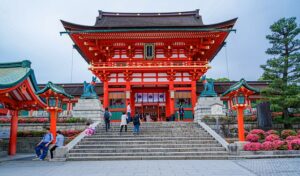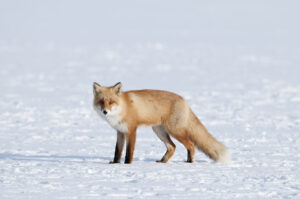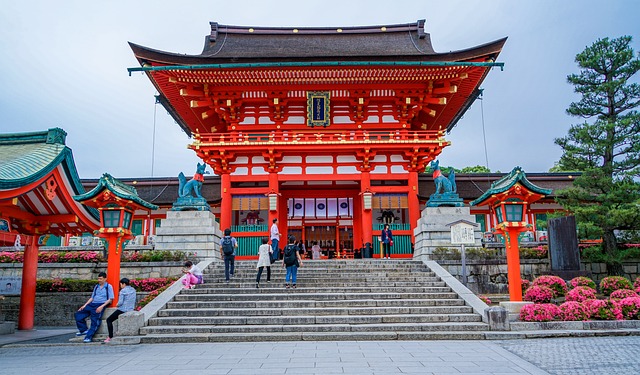日本で2番めに多い神社 もうひとつは稲荷神社

個体の神社の数としては、稲荷社が2番めです。
稲荷大明神(いなりだいみょうじん)、お稲荷様・お稲荷さんともいい、
貴狐天皇(ダキニ天)、ミケツ(三狐・御食津)、野狐、狐、飯綱とも混同されます。
稲荷系の神社では、
玉藻の前(九尾の狐・殺生石)が祭られていることもあるそうです。
神社としては、伏見稲荷大社の宇迦之御魂大神が中心になります。
稲荷は京都の稲荷山。
白鳥が山におり、稲がなったので稲荷山(稲がなった山)。
古代より、日本に帰化しテクノクラート集団として
深草に一大勢力のあった豪族の秦氏。
都が京都に移ると、
地盤に勢力のあった秦氏の影響力が自然に強く、
その守護神として広く知られるようになり、
真言宗の東寺創建の際、
稲荷山から木材を提供したことにより、
真言宗の守護神として全国に広がっていきます。
日本には欠かせない稲作の神として、
農業神とて全国に広がり、
その御利益が江戸時代に商売繁盛としても広がり、
いまの隆盛につながっています。
東京には会社や、個人宅まで稲荷の社があります。
稲荷と狐はしばしば同一視されており、
野狐、狐、飯綱、玉藻の前(九尾の狐・殺生石)や、
貴狐天皇(ダキニ天)などが習合されていることもあり、
良くないイメージでとらえている方も多いです。
また、福徳万能であることから
願いの念を多く向けられることがあるからでしょう。
稲荷神は元々は農業の神様ですから、
狐は穀物を食い荒らすネズミを捕食すること、
狐の色や尻尾の形が実った稲穂に似ていることから、
狐が稲荷神の使いになりました。
狐といいますが、神様ではなく
神様のご眷属(使い)、また使いからはぐれたもの、
最初から野にあったもの、それぞれ違いがあります。
使いからはぐれたもの。
最初から野にあったものが、良くないイメージのひとつ。
もともと、欲に動きやすいです。
神様、神様のご眷属(使い)は、扱いを悪くすると、自分に返ってきます。
ただ、これらも人間の生活の上で起こることです。
畑や商売は人間の生活のもと、自分の力だけでは解決できないものが多いです。
神様の加護を求めるのは自然のことで。
願いが悪いのではなく、願いにどういう念をのせるかで、神様も変わってゆきます。
守り神にかるのか、妖怪にするのかは、付き合い方なのだと思います。
神様も拝んでいくと対応が変わってきます!

The second most common shrine in Japan: Another one is the Inari Shrine
In terms of the number of individual shrines, Inari Shrine is the second most common.
Inari Daimyojin (also known as O-Inari-sama or O-Inari-san) is often confused with Dakini Ten (Emperor Dakini), Miketsu (Three Foxes, Divine Food), field foxes, foxes, and Iizuna.
In Inari-related shrines, it is said that Tamamo-no-Mae (Nine-Tailed Fox, Sessho-seki) is sometimes worshipped. As a shrine, the central deity is Ukanomitama-no-Okami of Fushimi Inari Taisha.
Inari is Inari Mountain in Kyoto. A swan landed on the mountain and rice grew, so it’s called Inari Mountain (the mountain where rice grew). Since ancient times, the Hata clan, a powerful family that had a major influence in Fushimi, had been naturalized in Japan and formed a technocrat group.
When the capital moved to Kyoto, the influence of the Hata clan, which had a strong base, naturally became strong, and it became widely known as their guardian deity.
When the Shingon sect’s To-ji was founded, they provided timber from Inari Mountain, and it spread nationwide as the guardian deity of the Shingon sect.
As an indispensable god of rice cultivation in Japan, it spread nationwide as an agricultural god, and its benefits spread as business prosperity during the Edo period, leading to its current prosperity. In Tokyo, there are Inari shrines in companies and private homes.
Inari and foxes are often equated, and it is often misunderstood due to the syncretism of field foxes, foxes, Iizuna, Tamamo-no-Mae (Nine-Tailed Fox, Sessho-seki), and Dakini Ten (Emperor Dakini).
Also, because it is a god of all-around fortune, it may be often directed by many wishes. After all, the Inari god is originally a god of agriculture.
Foxes prey on mice that devastate grains, and because the color and shape of a fox’s tail resemble ripe rice ears, foxes became the messengers of the Inari god.
Although we say foxes, they are not gods but the servants of gods, those who have strayed from the servants, those who were originally in the field, and each has a difference.
Those who have strayed from the servants. One of the bad images is those who were originally in the field. They are originally easy to move by desire.
Gods, the servants of gods, if you treat them badly, it will come back to you. However, these are also things that happen in human life. Fields and businesses are the basis of human life, and there are many things that cannot be solved by one’s own power.
It is natural to seek the protection of the gods.
It’s not that the wish is bad, but depending on what kind of thought you put on the wish, the god will change. Whether to make it a guardian deity or a monster depends on how you deal with it. The response of the god will change as you worship!
|
|


![[商品価格に関しましては、リンクが作成された時点と現時点で情報が変更されている場合がございます。] [商品価格に関しましては、リンクが作成された時点と現時点で情報が変更されている場合がございます。]](https://hbb.afl.rakuten.co.jp/hgb/3a51381e.4f3a70a5.3a51381f.7ec76cc2/?me_id=1418123&item_id=10000062&pc=https%3A%2F%2Fthumbnail.image.rakuten.co.jp%2F%400_mall%2Fr1-shop%2Fcabinet%2F10018776%2F10165018%2F10655390%2Fcs-60.jpg%3F_ex%3D240x240&s=240x240&t=picttext)



コメント